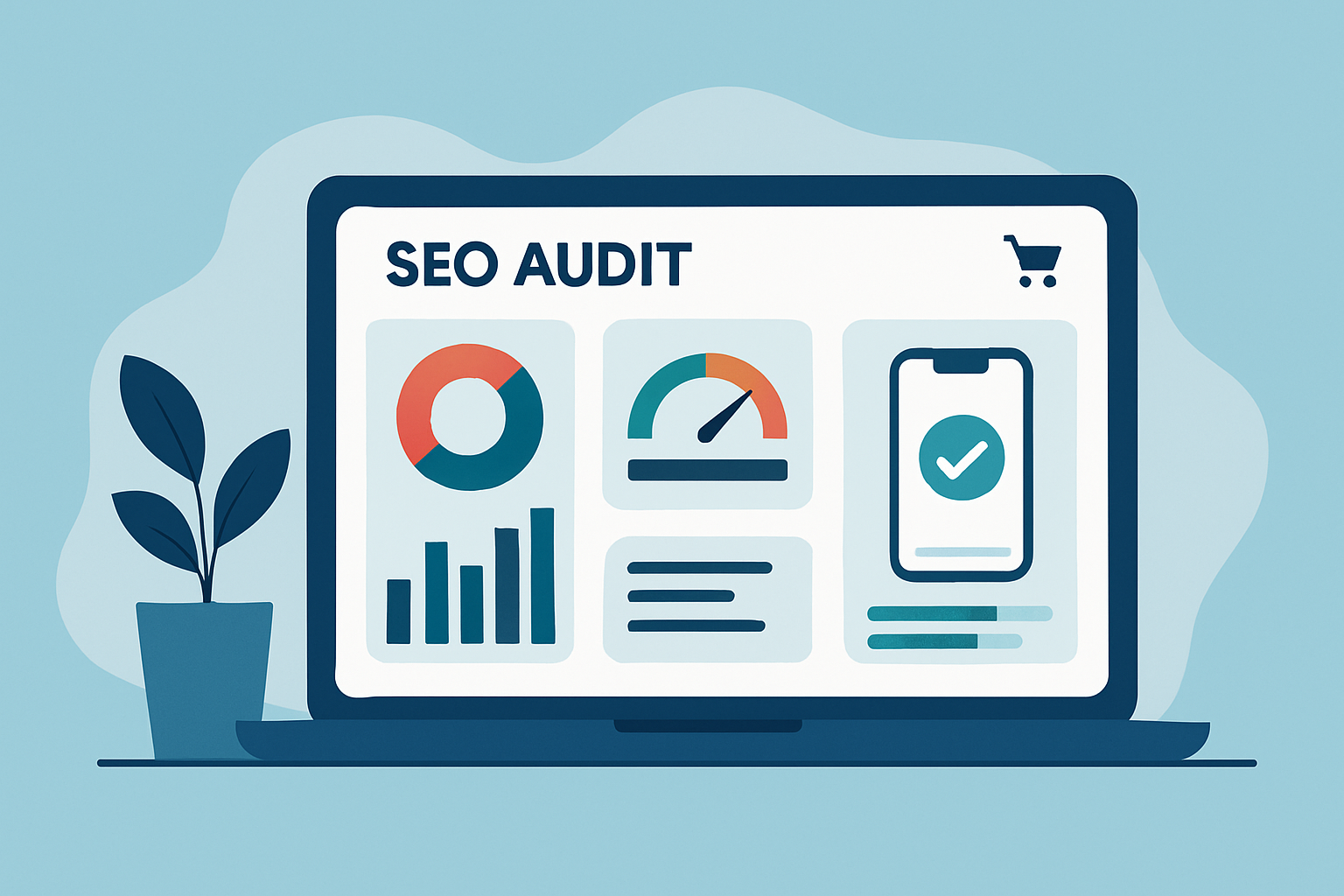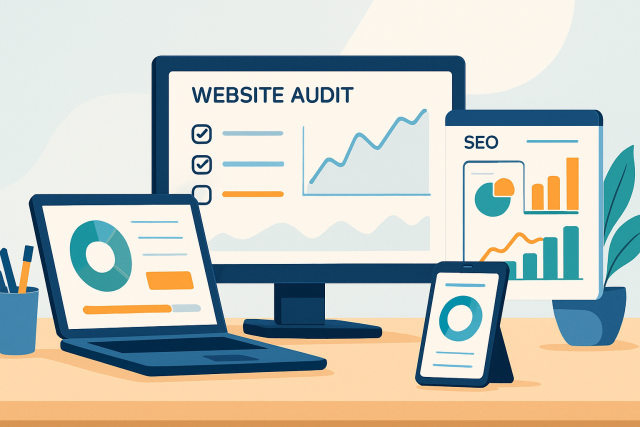Essential Steps for Your Ecommerce SEO Audit Process


An ecommerce SEO audit is a real game-changer for online stores aiming to boost their visibility and reel in more traffic to drive sales. Ecommerce sites often wrestle with the tricky task of optimizing their sprawling product inventories and tangled category layouts.
Getting to Know the Essentials of an Ecommerce SEO Audit The Basics You Cannot Afford to Miss
An ecommerce SEO audit dives deep into how your online store holds up in search engines by focusing on unique elements like product pages and detailed category structures. It also examines the overall shopping experience your customers go through.
- Technical SEO is about making sure search engines can crawl and index your site without errors.
- On-page SEO involves fine-tuning titles, descriptions and the content on your product and category pages.
- Content quality looks at how unique and valuable your product descriptions and blog posts really are—it’s where your content either sings or falls flat.
- Backlink profile review dives into the quality and relevance of the external links pointing to your site because not all backlinks are created equal.
- Site architecture evaluation examines how your categories are set up, the URL structure and the way your internal links connect your pages. Think of it as the blueprint for a smooth visitor journey.
- User experience analysis focuses on navigation, mobile friendliness and site speed to help lower bounce rates and keep visitors engaged longer than they might expect.
Step 1 Perform Technical SEO Checks (because skipping this is like trying to build a house on sand)
Kick off your ecommerce SEO audit by taking a close careful look at those pesky technical issues that can trip up how search engines crawl and index your site. This means hunting down broken links and double-checking that HTTPS security is locked down tight. Size up mobile friendliness, eyeball load times, and make sure your XML sitemaps and robots.txt files are lined up just right to steer those crawl paths where you want them to go.
Grab an SEO crawler tool like Screaming Frog or Moz Pro to give your website a thorough once-over for crawl errors and broken links.
Hunt down and fix 404 errors, redirect loops and server hiccups that could trip up user experience and mess with your indexing.
Check your site’s page speed through Google PageSpeed Insights and focus on tweaks that reduce load times because nobody likes to wait.
Run Google’s Mobile-Friendly Test to make sure your store works smoothly and looks sharp on smartphones—it’s a must these days.
Double-check that your website runs on HTTPS with a valid SSL certificate to keep user data safe and boost your search rankings.
Give your XML sitemap and robots.txt file a quick once-over to ensure important pages can be crawled while keeping unnecessary content locked out.

Dashboard view of technical SEO audit results highlighting key website performance metrics
Step 2 Assess On-Page SEO Elements Because Getting the Basics Right Really Pays Off
Take a good look at all those on-page elements that give search engines a heads-up about your product and category pages. This involves checking title tags, meta descriptions, header tags, URLs and adding schema markup where it fits naturally.
- Make sure each product and category page has a unique title tag with relevant keywords. Keep it brief — under 60 characters works best.
- Create meta descriptions that include your main keywords and encourage users to click without sounding robotic.
- Use header tags H1, H2 and H3 to organize your content clearly and highlight important keywords.
- Keep URLs short and straightforward to fit well with your site's overall structure.
- Add schema markup like Product and Review schema to enhance your rich snippets in search results.
- Avoid stuffing keywords into your content and metadata. Instead, integrate them smoothly so they feel natural.
Step 3 Take a Good Look at Content Quality and How Users Actually Experience It
Strong content is the secret sauce for boosting ecommerce SEO and delivering genuine value for real people browsing your site. It’s worth carving out time to give your product descriptions a good once-over to ensure they stand out with unique detailed info. Don’t forget to sprinkle in user-generated content like reviews because they’re pure gold for building trust. Also steer clear of the dreaded duplicate content trap.
- Craft original detailed product descriptions that genuinely speak to your customers' needs and clear up their questions. Think of it as having a friendly chat rather than just listing specs.
- Shine a spotlight on user reviews and nudge customers to share their thoughts. This is a great way to build trust and add valuable keyword-rich content at the same time.
- Take a good hard look at your blog posts and guides to ensure they dig deep and stay on point for your audience. No surface-level fluff here.
- Hunt down and weed out duplicate content that often sneaks in because of product variants or pagination quirks or filtering. Search engines don’t like repeats.
- Use internal links wisely to weave together related products, categories and blog posts, making life easier for search engines trying to navigate your site.
- Double-check that your site navigation feels like a breeze with clear menus, filters and search options so users aren’t left hunting high and low when they want to find a product quickly.
Step 4 Take a Good, Hard Look at Your Backlink Profile and See How You Stack Up Against the Competition
Backlinks still hold quite a bit of sway when it comes to rankings, so it’s a good idea to keep a regular eye on your store’s backlink profile. Take a close look at both the quality and quantity of those external links, weed out any harmful ones that might be dragging you down.
Pull your current backlink profile using handy tools like Moz Pro or Mangools LinkMiner. This will give you a clear snapshot of your link landscape without any guesswork.
Take a close look at each link’s quality by considering domain authority and how relevant the site is and whether the anchor text is effective.
Find and disavow any spammy or low-quality backlinks that might be dragging down your SEO because nobody wants dead weight holding them back.
Check out your competitors' backlink profiles. It’s a smart way to assess your link strength and discover opportunities you might have missed.
Focus your outreach and content marketing efforts on acquiring high-quality backlinks that can boost your domain authority and help improve your rankings.
Step 5 Take a Good Hard Look at Site Architecture and URL Structure
A thoughtfully designed site structure can really give your SEO a leg up by making it easier for both users and search engines to navigate your ecommerce store without breaking a sweat. Take a good hard look at how your categories and subcategories are laid out. Keep those URL hierarchies clean and simple.
- Make sure your category hierarchy feels logical and straightforward with main categories and clear subcategories that don’t dive too deep.
- Keep URL paths shallow to avoid long tangled links that nobody likes. Usually aiming for three levels or fewer works well.
- Stick to consistent URL formats that use readable words, relevant keywords and hyphens to keep things tidy.
- Don’t forget to add breadcrumb navigation on every page. It helps users know where they are and gives your internal linking a helpful boost.
- Hunt down and fix those pesky orphan pages with no internal links pointing to them because otherwise search engines might ignore them.
Step 6 Keep an Eye on Performance Metrics and Set Clear, Achievable Goals
Wrap up your ecommerce SEO audit by keeping a close eye on key performance indicators using tools like Google Analytics or Moz Pro. You can also use Mangools rank tracking. Keep tabs on organic traffic, keyword rankings, bounce rates and conversion rates to help you make important your SEO efforts and see how things improve over time.
- Keep a close eye on organic traffic trends to identify which pages are really attracting visitors and which ones might need some extra attention.
- Track keyword rankings for your top terms to monitor your progress and catch any sudden drops before they become a problem.
- Don’t forget to check page load times because speeding up slow pages can greatly reduce those dreaded bounce rates.
- Carefully review bounce rates on your main landing pages since improving them can significantly boost user engagement and make your content resonate better.
- Keep track of conversion rates from organic search to ensure your SEO efforts are turning into solid sales.
Unlock Digital Marketing Success with Moz
Struggling to optimize your online presence? Moz is the ultimate Internet Marketing solution, empowering businesses with powerful SEO tools, insightful analytics, and expert guidance. Elevate your digital strategies and outshine the competition.
- Boost organic traffic with data-driven SEO tactics
- Enhance content marketing with expert recommendations
- Gain a competitive edge with comprehensive link analysis








